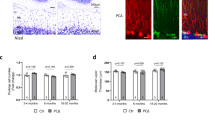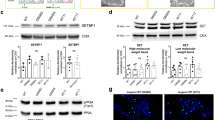Abstract
Ataxia-telangiectasia is a human syndrome resulting from mutations of the ATM protein kinase that is characterized by radiation sensitivity and neurodegeneration. Although neuroprotective, the molecular details of ATM function in the nervous system are uncertain. However, in the mouse, Atm is essential for ionizing radiation-induced apoptosis in select postmitotic populations of the developing nervous system. Atm-dependent apoptosis in the nervous system also requires p53, consistent with the well-established link of p53 as a major substrate of ATM. Furthermore, the proapoptotic effector Bax is also required for most, but not all, Atm-dependent apoptosis. Therefore, after DNA damage in the developing nervous system, Atm initiates a p53-dependent apoptotic cascade in differentiating neural cells. Together, these data suggest ATM-dependent apoptosis may be important for elimination of neural cells that have accumulated genomic damage during development, thus preventing dysfunction of these cells later in life.
Similar content being viewed by others
References
Sedgwick RP, Boder E. Ataxia-Telangiectasia. In Handbook of Clinical Neurology, Vol. 60Vinken P, Bruyn G, Klawans H. eds. 347–423 New York: Elsevier, 1991.
Canman CE, Lim DS. The role of ATM in DNA damage responses and cancer. Oncogene1998;17:3301–3308.
Lavin MF, Shiloh Y. The genetic defect in ataxia-telangiectasia. Annu Rev Immunol1997;15:177–202.
Rotman G, Shiloh Y. ATM: From gene to function. Hum Mol Genet1998;7:1555–1563.
Soares HD, Morgan JI, McKinnon PJ. Atm expression patterns suggest a contribution from the peripheral nervous system to the phenotype of ataxia-telangiectasia. Neurosciencea1998;86:1045–1054.
Barlow C, Hirotsune S, Paylor R, Liyanage M, Eckhaus M, Collins F, Shiloh Y, Crawley JN, Ried T, Tagle D, Wynshaw-Boris A. Atm-deficient mice: A paradigm of ataxia telangiectasia. Cell1996;86:159–171.
Elson A, Wang Y, Daugherty CJ, Morton CC, Zhou F, Campos-Torres J, Leder P. Pleiotropic defects in ataxiatelangiectasia protein-deficient mice. Proc Natl Acad Sci (USA)1996;93:13084–13089.
Herzog KH, Chong MJ, Kapsetaki M, Morgan JI, McKinnon PJ. Requirement for Atm in ionizing radiationinduced cell death in the developing central nervous system. Science1998;280:1089–1091.
Savitsky K, Bar-Shira A, Gilad S, Rotman G, Ziv Y, Vanagaite L, Tagle DA, Smith S, Uziel T, Sfez S, et al. A single ataxia telangiectasia gene with a product similar to PI-3 kinase. Science1995;268:1749–1753.
XuY, Ashley T, Brainerd EE, Bronson RT, Meyn MS, Baltimore D. Targeted disruption of TIATM leads to growth retardation, chromosomal fragmentation during meiosis, immune defects, and thymic lymphoma. Genes and Development1996;10: 2411–2422.
Dasika GK, Lin SC, Zhao S, Sung P, Tomkinson A, Lee EY. DNA damage-induced cell cycle checkpoints and DNA strand break repair in development and tumorigenesis. Oncogene1999;18:7883–7899.
Kastan MB, Zhan Q, El-Deiry WS, Carrier F, Jacks T, Walsh WV, Plunkett BS, Vogelstein B, Fornace Jnr. AJ.Amammalian Y. Lee and P.J. McKinnon cell cycle checkpoint pathway utilizing p53 and GADD45 is defective in ataxia telangiectasia. Cell1992;71:587–597.
Chong MJ, Murray MR, Gosink EC, Russell HR, Srinivasan A, Kapsetaki M, Korsmeyer SJ, McKinnon PJ. Atm and Bax cooperate in ionizing radiation-induced apoptosis in the central nervous system. Proc Natl Acad Sci USA2000;97:889–894.
Young RW. Cell differentiation in the retina of the mouse. Anat Rec1985;212:199–205.
Tibbetts RS, Brumbaugh KM, Williams JM, Sarkaria JN, Cliby WA, Shieh SY, Taya Y, Prives C, Abraham RT. A role for ATR in the DNA damage-induced phosphorylation of p53. Genes Dev1999;13:152–157.
Jacobsen M. Developmental Neurobiology, New York: Plenum Press, 1991.
Gosink EC, Chong MJ, McKinnon PJ. Ataxia telangiectasia mutated deficiency affects astrocyte growth but not radiosensitivity. Cancer Res1999;59:5294–5298.
Ashcroft M, Vousden KH. Regulation of p53 stability. Oncogene1999;18:7637–7643.
Giaccia AJ, Kastan MB. The complexity of p53 modulation: Emerging patterns from divergent signals. Genes Dev1998;12:2973–2983.
Lakin ND, Jackson SP. Regulation of p53 in response to DNA damage. Oncogene1999;18:7644–7655.
Lowe SW. Activation of p53 by oncogenes. Endocr Relat Cancer1999;6:45–48.
Wood KA, Youle RJ. The role of free radicals and p53 in neuron apoptosis in vivo. J Neurosci1995;15:5851–5857.
Xiang H, Hochman DW, Saya H, Fujiwara T, Schwartzkroin PA, Morrison RS. Evidence for p53-mediated modulation of neuronal viability. J Neurosci1996;16:6753–6765.
Banin S, Moyal L, Shieh S, Taya Y, Anderson CW, Chessa L, Smorodinsky NI, Prives C, Reiss Y, Shiloh Y, Ziv Y. Enhanced phosphorylation of p53 by ATM in response to DNA damage. Science1998;281:1674–1677.
Canman CE, Lim DS, Cimprich KA, Taya Y, Tamai K, Sakaguchi K, Appella E, Kastan MB, Siliciano JD. Activation of the ATM kinase by ionizing radiation and phosphorylation of p53. Science1998;281:1677–1679.
Khanna KK, Keating KE, Kozlov S, Scott S, Gatei M, Hobson K, TayaY, Gabrielli B, Chan D, Lees-Miller SP, Lavin MF.ATM associates with and phosphorylates p53: Mapping the region of interaction. Nat Genet1998;20:398–400.
Chehab NH, Malikzay A, Appel M, Halazonetis TD. Chk2/hCds1 functions as a DNA damage checkpoint in G(1) by stabilizing p53. Genes Dev2000;14:278–288.
Hirao A, Kong YY, Matsuoka S, Wakeham A, Ruland J, Yoshida H, Liu D, Elledge SJ, Mak TW. DNA damageinduced activation of p53 by the checkpoint kinase Chk2. Science2000;287:1824–1827.
Shieh SY, Ahn J, Tamai K, Taya Y, Prives C. The human homologs of checkpoint kinases Chk1 and Cds1 (Chk2) phosphorylate p53 at multiple DNA damage-inducible sites. Genes Dev2000;14:289–300.
Waterman MJ, Stavridi ES, Waterman JL, Halazonetis TD. ATM-dependent activation of p53 involves dephosphorylation and association with 14–3–3 proteins. Nat Genet1998;19:175–178.
Meek DW. Mechanisms of switching on p53: A role for covalent modification? Oncogene1999;18:7666–7675.
Khosravi R, Maya R, Gottlieb T, Oren M, Shiloh Y, Shkedy D. Rapid ATM-dependent phosphorylation of MDM2 precedes p53 accumulation in response to DNA damage. Proc Natl Acad Sci USA1999;96:14973–14977.
Momand J, Wu HH, Dasgupta G. MDM2-master regulator of the p53 tumor suppressor protein. Gene2000;242:15–29.
Yap DB, Hsieh JK, Chan FS, Lu X. mdm2: A bridge over the two tumour suppressors, p53 and Rb. Oncogene1999;18:7681–7689.
Cregan SP, MacLaurin JG, Craig CG, Robertson GS, Nicholson DW, Park DS, Slack RS. Bax-dependent caspase-3 activation is a key determinant in p53-induced apoptosis in neurons. J Neurosci1999;19:7860–7869.
Xiang H, Kinoshita Y, Knudson CM, Korsmeyer SJ, Schwartzkroin PA, Morrison RS. Bax involvement in p53-mediated neuronal cell death. J Neurosci1998;18:1363–1373.
Miyashita T, Reed JC. Tumor suppressor p53 is a direct transcriptional activator of the human bax gene. Cell1995;80:293–299.
Schmidt T, Korner K, Karsunky H, Korsmeyer S, Muller R, Moroy T. The activity of the murine Bax promoter is regulated by Sp1/3 and E-box binding proteins but not by p53. Cell Death Differ1999;6:873–882.
Oda E, Ohki R, Murasawa H, Nemoto J, Shibue T, Yamashita T, Tokino T, Taniguchi T, Tanaka N. Noxa, a BH3-only member of the bcl-2 family and candidate mediator of p53-induced apoptosis. Science2000;288:1053–1058.
Hotti A, Jarvinen K, Siivola P, Holtta E. Caspases and mitochondria in c-Myc-induced apoptosis: Identification of ATM as a new target of caspases. Oncogene2000;19:2354–2362.
Smith GC, di Fagagna F, Lakin ND, Jackson SP. Cleavage and inactivation of ATM during apoptosis. Mol Cell Biol1999;19:6076–6084.
Wu GS, Burns TF, McDonald ER, 3rd Meng RD, Kao G, Muschel R,Yen T, el-Deiry WS. Induction of the TRAIL receptor KILLER/DR5 in p53-dependent apoptosis but not growth arrest. Oncogene1999;18:6411–6418.
Barlow C, Brown KD, Deng CX, Tagle DA, Wynshaw-Boris A. Atm selectively regulates distinct p53-dependent cell-cycle checkpoint and apoptotic pathways. Nat Genet1997;17: 453–456.
Westphal CH, Rowan S, Schmaltz C, Elson A, Fisher DE, Leder P. atm and p53 cooperate in apoptosis and suppression of tumorigenesis, but not in resistance to acute radiation toxicity. Nat Genet1997;16:397–401.
Takao N, Kato H, Mori R, Morrison C, Sonada E, Sun X, Shimizu H, Yoshioka K, Takeda S, Yamamoto K. Disruption of ATMin p53-null cells causes multiple functional abnormalities in cellular response to ionizing radiation. Oncogene1999;18:7002–7009.
Slichenmyer WJ, Nelson WG, Slebos RJ, Kastan MB. Loss of a p53-associated G1 checkpoint does not decrease cell survival following DNA damage. Cancer Res1993;53:4164–4168.
Lohrum MA, Vousden KH. Regulation and function of the p53-related proteins: Same family, different rules. Trends Cell Biol2000;10:197–202.
Agami R, Blandino G, Oren M, Shaul Y. Interaction of c-Abl and p73alpha and their collaboration to induce apoptosis. Nature1999;399:809–813.
Gong JG, Costanzo A, Yang HQ, Melino G, Kaelin WG, Jr. Levrero M, Wang JY. The tyrosine kinase c-Abl regulates p73 in apoptotic response to cisplatin-induced DNA damage. Nature1999;399:806–809.
Yuan ZM, Shioya H, Ishiko T, Sun X, Gu J, Huang YY, Lu H, Kharbanda S, Weichselbaum R, Kufe D. p73 is regulated by tyrosine kinase c-Abl in the apoptotic response to DNA damage. Nature1999;399:814–817.
Baskaran R, Wood LD, Whitaker LL, Canman CE, Morgan SE, Xu Y, Barlow C, Baltimore D, Wynshaw-Boris A, Kastan MB, Wang JY. Ataxia telangiectasia mutant protein activates c-Abl tyrosine kinase in response to ionizing radiation. Nature1997;387:516–519.
Shafman T, Khanna KK, Kedar P, Spring K, Kozlov S, Yen T, Hobson K, Gatei M, Zhang N, Watters D, et al.Interaction between ATM protein and c-Abl in response to DNA damage. Nature1997;387:520–523.
Kim ST, Lim DS, Canman CE, Kastan MB. Substrate speci-ficities and identification of putative substrates of ATM kinase family members. J Biol Chem1999;274:37538–37543.
Cortez D, Wang Y, Qin J, Elledge SJ. Requirement of ATMdependent phosphorylation of brca1 in the DNA damage response to double-strand breaks. Science1999;286: 1162–1166.
Lim DS, Kim ST, Xu B, Maser RS, Lin J, Petrini JH, Kastan MB. ATM phosphorylates p95/nbs1 in an S-phase checkpoint pathway. Nature2000;404:613–617.
Liao WC, Haimovitz-Friedman A, Persaud RS, McLoughlin M, Ehleiter D, Zhang N, Gatei M, Lavin M, Kolesnick R, Fuks Z. Ataxia telangiectasia-mutated gene product inhibits DNA damage-induced apoptosis via ceramide synthase. J Biol Chem1999;274:17908–17917.
McKinnon PJ. Ataxia-telangiectasia: An inherited disorder of ionizing radiation sensitivity in man. Human Genetics1987;75:197–208.
Liao MJ, Van Dyke T. Critical role for Atm in suppressing V(D)J recombination-driven thymic lymphoma. Genes Dev1999;13:1246–1250.
Suzuki K, Kodama S, Watanabe M. Recruitment of ATM protein to double strand DNA irradiated with ionizing radiation. J Biol Chem1999;274:25571–25575.
Morrison C, Sonoda E, Takao N, Shinohara A, Yamamoto K, Takeda S. The controlling role of ATM in homologous recombinational repair of DNA damage. Embo J2000;19:463–471.
Brown KD, Lataxes TA, Shangary S, Mannino JL, Giardina JF, Chen J, Baskaran R. Ionizing radiation exposure results in upregulation of Ku70 via a p53/Ataxia-Telangiectasia-mutated Protein-dependent mechanism. J Biol Chem2000;275:6651–6656.
Gatei M, Young D, Cerosaletti KM, Desai-Mehta A, Spring K, Kozlov S, Lavin MF, Gatti RA, Concannon P, Khanna K. ATMdependent phosphorylation of nibrin in response to radiation exposure. Nat Genet2000;25:115–119.
Rolig RL, McKinnon PJ. Linking DNA damage and neurodegeneration. Trends Neurosci2000;23:417–424.
Stewart GS, Maser RS, Stankovic T, Bressan DA, Kaplan MI, Jaspers NG, Raams A, Byrd PJ, Petrini JH, Taylor AM. The DNA double-strand break repair gene hMRE11 is mutated in individuals with an ataxia-telangiectasia-like disorder. Cell1999;99:577–587.
Barnes DE, Stamp G, Rosewell I, Denzel A, Lindahl T. Targeted disruption of the gene encoding DNA ligase IV leads to lethality in embryonic mice. Curr Biol1998;8:1395–1398.
Gao Y, Sun Y, Frank KM, Dikkes P, Fujiwara Y, Seidl KJ, Sekiguchi JM, Rathbun GA, SwatW, Wang J, et al.A critical role for DNA end-joining proteins in both lymphogenesis and neurogenesis. Cell1998;95:891–902.
Sugo N, Aratani Y, Nagashima Y, Kubota Y, Koyama H. Neonatal lethality with abnormal neurogenesis in mice defi-cient in DNA polymerase beta. Embo J2000;19:1397–1404.
Gu Y, Sekiguchi J, Gao Y, Dikkes P, Frank K, Ferguson D, Hasty P, Chun J, Alt FW. Defective embryonic neurogenesis in Ku-deficient but not DNA-dependent protein kinase catalytic subunit-deficient mice. Proc Natl Acad Sci USA2000;97:2668–2673.
Chun J, Schatz DG. Rearranging views on neurogenesis: Neuronal death in the absence ofDNAend-joining proteins. Neuron1999;22:7–10.
Gilmore EC, Nowakowski RS, Caviness VS, Jr, Herrup K. Cell birth, cell death, cell diversity and DNA breaks: How do they all fit together? Trends Neurosci2000;23:100–105.
GaoY, Ferguson DO, XieW, Manis JP, Sekiguchi J, Frank KM, Chauduri J, Horner J, DePinho RA, Alt FW. Interplay of p53 and DNA-repair protein XRCC4 in tumorigenesis, genomic stability and development. Nature2000;404:897–900.
Author information
Authors and Affiliations
Rights and permissions
About this article
Cite this article
Lee, Y., McKinnon, P.J. ATM dependent apoptosis in the nervous system. Apoptosis 5, 523–529 (2000). https://doi.org/10.1023/A:1009637512917
Issue Date:
DOI: https://doi.org/10.1023/A:1009637512917




